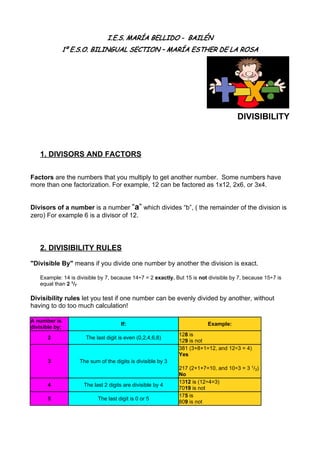
Unit3[1].doc
- 1. I.E.S. MARÍA BELLIDO - BAILÉN 1º E.S.O. BILINGUAL SECTION – MARÍA ESTHER DE LA ROSA DIVISIBILITY 1. DIVISORS AND FACTORS Factors are the numbers that you multiply to get another number. Some numbers have more than one factorization. For example, 12 can be factored as 1x12, 2x6, or 3x4. Divisors of a number is a number “a” which divides “b”, ( the remainder of the division is zero) For example 6 is a divisor of 12. 2. DIVISIBILITY RULES "Divisible By" means if you divide one number by another the division is exact. Example: 14 is divisible by 7, because 14÷7 = 2 exactly. But 15 is not divisible by 7, because 15÷7 is equal than 2 1/7 Divisibility rules let you test if one number can be evenly divided by another, without having to do too much calculation! A number is If: Example: divisible by: 128 is 2 The last digit is even (0,2,4,6,8) 129 is not 381 (3+8+1=12, and 12÷3 = 4) Yes 3 The sum of the digits is divisible by 3 217 (2+1+7=10, and 10÷3 = 3 1/3) No 1312 is (12÷4=3) 4 The last 2 digits are divisible by 4 7019 is not 175 is 5 The last digit is 0 or 5 809 is not
- 2. 114 (it is even, and 1+1+4=6 and 6÷3 = 2) Yes 6 The number is divisible by both 2 and 3 308 (it is even, but 3+0+8=11 and 11÷3 = 3 2/3) No 672 (Double 2 is 4, 67-4=63, and 63÷7=9) Yes 7 If you double the last digit and subtract it from the rest of the number and the answer is: 905 (Double 5 is 10, 90-10=80, 0, or divisible by 7 and 80÷7=11 3/7) No (Note: you can apply this rule to that answer again if you want) 8 The last three digits are divisible by 8 109816 (816÷8=102) Yes 216302 (302÷8=37 3/4) No The sum of the digits is divisible by 9 1629 (1+6+2+9=18, and again, 1+8=9) Yes 9 (Note: you can apply this rule to that answer again if you want) 2013 (2+0+1+3=6) No 220 is 10 The number ends in 0 221 is not 1364 ((3+4) - (1+6) = 0) Yes If you sum every second digit and then 3729 ((7+9) - (3+2) = 11) Yes 11 subtract all other digits and the answer is 25176 ((5+7) - (2+1+6) = 3) No 0, or divisible by 11 12 The number is divisible by both 3 and 4 648 (6+4+8=18 and 18÷3=6, also 48÷4=12) Yes 916 (9+1+6=16, 16÷3= 5 1/3) No 3. PRIME NUMBERS AND COMPOSITE NUMBERS A PRIME NUMBER has only two factors, one and itself, so it cannot be divided evenly by any other numbers. PRIME NUMBERS to 100 : 2,3,5,7,11,13,17,19,23,29,31,37,41,43,47,53,59, 61,67,71,73,79,83,89,97 A COMPOSITE NUMBER is any number that has more than two factors.
- 3. COMPOSITE NUMBERS up to 20 4,6,8,9,10,12,14,15,16,18,20 By the way, zero and one are considered neither prime nor composite numbers. 4. PRIME FACTORIZATION Factoring a number means taking the number apart to find its factors, it's like multiplying in reverse. Here are lists of all the factors of 60: 60 --> 1, 2, 3,4, 5, 6, 10, 12, 15, 20, 30, 60 Factors are either composite numbers or prime numbers. If you write any composite number as a product of prime factors, this is called PRIME FACTORIZATION. To find the prime factors of a number, you divide the number by the smallest possible prime number and work up the list of prime numbers until the result is itself a prime number. EXAMPLE: Let's use this method to find the prime factors of 168. 168 ÷ 2 = 84 84 ÷ 2 = 42 2 ÷ 2 = 21 21 ÷ 3 = 7 Prime number PRIME FACTORIZATION = 2 × 2 × 2 × 3 × 7 (To check the answer, multiply these factors and make sure they equal 168) 5. GREATEST COMMON DIVISOR. GREATEST COMMON DIVISOR (GCD): is the largest number that divides exactly into every member of a group of numbers. There are two ways to find the GCD: Method 1: Find all of the factors of each number, then list the common factors and choose the largest one.
- 4. Example: Factors of 4: 1, 2, 4 Factors of 8: 1, 2, 4, 8. Factors of 12: 1, 2, 3, 4, 6, 12 Common factors of 4, 8, and 12: 2, 4 so the largest is 4. Method 2: You must find the prime factorizations of the numbers. Then you take only the common factors raised to the lowest exponent. Finally, multiply all of these: Example: 4 = 2x2 12 = 2x2x3 GCD (4, 12) = 4 6. LOWEST COMMON MULTIPLE. LOWEST COMMON MULTIPLE (LCM): is the lowest number into which every member of a group of numbers divides exactly. There are two ways to find the LCM of several numbers. Method 1: List the multiples of the larger number and stop when you find a multiple of the other number. This will be the LCM. Example: We are going to find the LCM(6,8): Multiples of 6 = 6,12,18,24,30,36,... Multiples of 8= 8,16,24 stop! LCM(6,8) = 24. Method 2: You must find the prime factorizations of the numbers. Then you choose all the factors (common and non common) raised to the highest exponent. Finally, multiply all of these factors getting the LCM. Example: We are going to find the LCM(12,8): 12 = 2x2x3 8 = 2x2x2 Then LCM(12,8) = 2x2x2x3 = 24